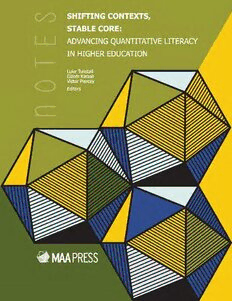
Shifting contexts, stable core : advancing quantitative literacy in higher education PDF
Preview Shifting contexts, stable core : advancing quantitative literacy in higher education
Shifting Contexts, Stable Core Advancing Quantitative Literacy in Higher Education (cid:13)c 2019by TheMathematicalAssociationofAmerica(Incorporated) LibraryofCongressControlNumber2019933456 PrintISBN978-0-88385-198-2 ElectronicISBN978-1-61444-324-7 PrintedintheUnitedStatesofAmerica CurrentPrinting(lastdigit): 10987654321 Shifting Contexts, Stable Core Advancing Quantitative Literacy in Higher Education Edited by Luke Tunstall, Gizem Karaali, and Victor Piercey PublishedandDistributedby TheMathematicalAssociationofAmerica The MAA Notes Series, started in 1982, addresses a broad range of topics and themes of interest to all who are involved with undergraduatemathematics.Thevolumesinthisseriesarereadable,informative,anduseful,andhelpthemathematicalcommunity keepupwithdevelopmentsofimportancetomathematics. CouncilonPublicationsandCommunications SusanG.Staples,Chair NotesEditorialBoard MichaelC.Axtell,Editor CristaL.Arangala VinodhKumarChellamuthu SuzanneHamon HeatherA.Hulett DavidR.Mazur DanSloughter JoeYanik JohnM.Zobitz MAANotes 14. MathematicalWriting,byDonaldE.Knuth,TracyLarrabee,andPaulM.Roberts. 16. UsingWritingtoTeachMathematics,AndrewSterrett,Editor. 17. PrimingtheCalculusPump:InnovationsandResources,CommitteeonCalculusReformandtheFirstTwoYears,asubcomit- teeoftheCommitteeontheUndergraduatePrograminMathematics,ThomasW.Tucker,Editor. 18. ModelsforUndergraduateResearchinMathematics,LesterSenechal,Editor. 19. VisualizationinTeachingandLearningMathematics,CommitteeonComputersinMathematicsEducation,SteveCunning- hamandWalterS.Zimmermann,Editors. 20. TheLaboratoryApproachtoTeachingCalculus,L.CarlLeinbachetal.,Editors. 21. PerspectivesonContemporaryStatistics,DavidC.HoaglinandDavidS.Moore,Editors. 22. HeedingtheCallforChange:SuggestionsforCurricularAction,LynnA.Steen,Editor. 24. SymbolicComputationinUndergraduateMathematicsEducation,ZavenA.Karian,Editor. 25. TheConceptofFunction:AspectsofEpistemologyandPedagogy,GuershonHarelandEdDubinsky,Editors. 26. StatisticsfortheTwenty-FirstCentury,FlorenceandSheldonGordon,Editors. 27. ResourcesforCalculusCollection,Volume1:LearningbyDiscovery:ALabManualforCalculus,AnitaE.Solow,Editor. 28. ResourcesforCalculusCollection,Volume2:CalculusProblemsforaNewCentury,RobertFraga,Editor. 29. ResourcesforCalculusCollection,Volume3:ApplicationsofCalculus,PhilipStraffin,Editor. 30. ResourcesforCalculusCollection,Volume4:ProblemsforStudentInvestigation,MichaelB.JacksonandJohnR.Ramsay, Editors. 31. ResourcesforCalculusCollection,Volume5:ReadingsforCalculus,UnderwoodDudley,Editor. 32. EssaysinHumanisticMathematics,AlvinWhite,Editor. 33. ResearchIssuesinUndergraduateMathematicsLearning:PreliminaryAnalysesandResults,JamesJ.KaputandEdDubinsky, Editors. 34. InEves’Circles,JobyMiloAnthony,Editor. 35. You’retheProfessor,WhatNext?IdeasandResourcesforPreparingCollegeTeachers,TheCommitteeonPreparationfor CollegeTeaching,BettyeAnneCase,Editor. 36. PreparingforaNewCalculus:ConferenceProceedings,AnitaE.Solow,Editor. 37. APracticalGuidetoCooperativeLearninginCollegiateMathematics,NancyL.Hagelgans,BarbaraE.Reynolds,SDS,Keith Schwingendorf,DragaVidakovic,EdDubinsky,MazenShahin,G.JosephWimbish,Jr. 38. ModelsThatWork:CaseStudiesinEffectiveUndergraduateMathematicsPrograms,AlanC.Tucker,Editor. 39. Calculus:TheDynamicsofChange,CUPMSubcommitteeonCalculusReformandtheFirstTwoYears,A.WayneRoberts, Editor. 40. VitaMathematica:HistoricalResearchandIntegrationwithTeaching,RonaldCalinger,Editor. 41. GeometryTurnedOn:DynamicSoftwareinLearning,Teaching,andResearch,JamesR.KingandDorisSchattschneider, Editors. 42. ResourcesforTeachingLinearAlgebra,DavidCarlson,CharlesR.Johnson,DavidC.Lay,A.DuanePorter,AnnE.Watkins, WilliamWatkins,Editors. 43. StudentAssessmentinCalculus:AReportoftheNSFWorkingGrouponAssessmentinCalculus,AlanSchoenfeld,Editor. 44. ReadingsinCooperativeLearningforUndergraduateMathematics,EdDubinsky,DavidMathews,andBarbaraE.Reynolds, Editors. 45. ConfrontingtheCoreCurriculum:ConsideringChangeintheUndergraduateMathematicsMajor,JohnA.Dossey,Editor. 46. WomeninMathematics:ScalingtheHeights,DeborahNolan,Editor. 47. ExemplaryProgramsinIntroductoryCollegeMathematics:InnovativeProgramsUsingTechnology,SusanLenker,Editor. 48. WritingintheTeachingandLearningofMathematics,JohnMeierandThomasRishel. 49. AssessmentPracticesinUndergraduateMathematics,BonnieGold,Editor. 50. RevolutionsinDifferentialEquations:ExploringODEswithModernTechnology,MichaelJ.Kallaher,Editor. 51. UsingHistorytoTeachMathematics:AnInternationalPerspective,VictorJ.Katz,Editor. 52. TeachingStatistics:ResourcesforUndergraduateInstructors,ThomasL.Moore,Editor. 53. GeometryatWork:PapersinAppliedGeometry,CatherineA.Gorini,Editor. 54. TeachingFirst:AGuideforNewMathematicians,ThomasW.Rishel. 55. Cooperative Learning in Undergraduate Mathematics: Issues That Matter and Strategies That Work, Elizabeth C. Rogers, BarbaraE.Reynolds,NeilA.Davidson,andAnthonyD.Thomas,Editors. 56. ChangingCalculus:AReportonEvaluationEffortsandNationalImpactfrom1988to1998,SusanL.Ganter. 57. LearningtoTeachandTeachingtoLearnMathematics:ResourcesforProfessionalDevelopment,MatthewDelongandDale Winter. 58. Fractals,Graphics,andMathematicsEducation,BenoitMandelbrotandMichaelFrame,Editors. 59. Linear Algebra Gems: Assets for Undergraduate Mathematics, David Carlson, Charles R. Johnson, David C. Lay, and A. DuanePorter,Editors. 60. InnovationsinTeachingAbstractAlgebra,AllenC.HibbardandEllenJ.Maycock,Editors. 61. ChangingCoreMathematics,ChrisArneyandDonaldSmall,Editors. 62. AchievingQuantitativeLiteracy:AnUrgentChallengeforHigherEducation,LynnArthurSteen. 64. LeadingtheMathematicalSciencesDepartment:AResourceforChairs,TinaH.Straley,MarciaP.Sward,andJonW.Scott, Editors. 65. InnovationsinTeachingStatistics,JoanB.Garfield,Editor. 66. MathematicsinServicetotheCommunity:Conceptsandmodelsforservice-learninginthemathematicalsciences,Charles R.Hadlock,Editor. 67. InnovativeApproachestoUndergraduateMathematicsCoursesBeyondCalculus,RichardJ.Maher,Editor. 68. FromCalculustoComputers:Usingthelast200yearsofmathematicshistoryintheclassroom,AmyShell-GellaschandDick Jardine,Editors. 69. AFreshStartforCollegiateMathematics:RethinkingtheCoursesbelowCalculus,NancyBaxterHastings,Editor. 70. CurrentPracticesinQuantitativeLiteracy,RickGillman,Editor. 71. WarStoriesfromAppliedMath:UndergraduateConsultancyProjects,RobertFraga,Editor. 72. HandsOnHistory:AResourceforTeachingMathematics,AmyShell-Gellasch,Editor. 73. Making the Connection: Research and Teaching in Undergraduate Mathematics Education, Marilyn P. Carlson and Chris Rasmussen,Editors. 74. ResourcesforTeachingDiscreteMathematics:ClassroomProjects,HistoryModules,andArticles,BrianHopkins,Editor. 75. TheMooreMethod:APathwaytoLearner-CenteredInstruction,CharlesA.Coppin,W.TedMahavier,E.LeeMay,andG. EdgarParker. 76. TheBeautyofFractals:SixDifferentViews,DennyGulickandJonScott,Editors. 77. Mathematical Time Capsules: Historical Modules for the Mathematics Classroom, Dick Jardine and Amy Shell-Gellasch, Editors. 78. RecentDevelopmentsonIntroducingaHistoricalDimensioninMathematicsEducation,VictorJ.KatzandCostasTzanakis, Editors. 79. TeachingMathematicswithClassroomVoting:WithandWithoutClickers,KellyClineandHollyZullo,Editors. 80. ResourcesforPreparingMiddleSchoolMathematicsTeachers,CherylBeaver,LaurieBurton,MariaFung,andKlayKruczek, Editors. 81. UndergraduateMathematicsfortheLifeSciences:Models,Processes,andDirections,GlennLedder,JennaP.Carpenter,and TimothyD.Comar,Editors. 82. ApplicationsofMathematicsinEconomics,WarrenPage,Editor. 83. DoingtheScholarshipofTeachingandLearninginMathematics,JacquelineM.DewarandCurtisD.Bennett,Editors. 84. InsightsandRecommendationsfromtheMAANationalStudyofCollegeCalculus,DavidBressoud,VilmaMesa,andChris Rasmussen,Editors. 85. BeyondLecture:ResourcesandPedagogicalTechniquesforEnhancingtheTeachingofProof-WritingAcrosstheCurriculum, RachelSchwell,AlizaSteurerandJenniferF.Vasquez,Editors. 86. UsingthePhilosophyofMathematicsinTeachingUndergraduateMathematics,BonnieGold,CarlE.Behrens,andRogerA. Simons,Editors. 87. TheCoursesofHistory:IdeasforDevelopingaHistoryofMathematicsCourse,AmyShell-GellaschandDickJardine,Editors. 88. Shifting Contexts, Stable Core: Advancing Quantitative Literacy in Higher Education, Luke Tunstall, Gizem Karaali, and VictorPiercey,Editors. 89. MAA Instructional Practices Guide, Martha L. Abell, Linda Braddy, Doug Ensley, Lewis Ludwig, Hortensia Soto, Project LeadershipTeam. MAAServiceCenter P.O.Box91112 Washington,DC20090-1112 1-800-331-1MAA FAX:1-301-206-9789 Dedication InmemoryofCarenDiefenderfer,amuchlovedandadmiredteacherandscholar. Caren was distinguished not only for her outstanding achievements as a faculty member but also for her gentleness, generosity, modesty, and incredible care and consideration in interactions with the many whose lives she touched. She is an inspirationtoallofus—optimistic,encouraging,caring,andguiding. Foreword Considering Quantitative Literacy in the Context of Dewey, Data, and the Ever-shifting Landscape of a Democratic Society Susan L. Ganter Embry-Riddle Aeronautical University As societies become more complex in structure and resources, the need of formal or intentional teaching and learning increases. As formal teaching and training grow in extent, there is a danger of creating an undesirablesplitbetweentheexperiencegainedinmoredirectassociationsandwhatisacquiredinschool. Thisdangerwasnevergreaterthanatthepresenttime,onaccountoftherapidgrowthinthelastfewcenturies ofknowledgeandtechnicalmodesofskill. —JohnDewey,1916 The purpose and substance of a foreword is defined as a discussion about the relationship of the author to the story thebooktells [11].Myinteractionwith thestoryofquantitativeliteracy(QL)beganin1998,whenLynn Steen and Bob Orrill asked me to participate in a design team they were forming as part of the work of the National Council on Education and the Disciplines (NCED). The purpose of the design team was to discuss and develop a working definitionforQL,inlightofSteenandOrrill’srecentworkinWhyNumbersCount[9]. The design team first met in early 1998 and quickly realized the complexity of the task that had been assigned. BecauseQLasanacademicsubjectwasnew,conversationsturnedtohistoricalcontextsthatwouldsupportthedevel- opmentofadefinitionforQL.Amongmanyothers,theworksofJohnDeweyservedasarichsourceofinformation andinspirationforourattempttodefineQLinaconciseway.Specifically,DeweyurgedAmericansoftheearly20th centurytorememberthatchangeisalwaysmoreprominentthanthestatusquo,implyingthatourinterpretationoflit- eracymustconstantlyevolve,thatthis“istheneedofahumannatureandofasocietythatarethemselvesinprocessof constantchange”[4,8].Infact,Deweysaid,theverysuccessofourdemocraticsocietyisdependentuponindividual citizenswhocan“thinkforthemselves,”“judgeindependently,”andgenerallybeabletotellthedifferencebetween goodandbadinformation[4,8]. Whilethedifficultyofthetaskathandonlyincreasedasthedesignteammovedforward,theprofoundimportanceof theworkwouldnotallowforanythinglessthancompletecommitment.Even20yearsago,intheinfancyoftheinternet andaworldwidesuperhighwayofinformation,italreadywasincreasinglyclearthatthemagnitudeofinformationat our fingertips would only continue to increase. “[W]e are drowning in data, and there is unimaginably more on the way”[1,p.4].Nomorewilldatabeclarifiedandinterpretedforusbyaninformedelite—everyindividualwillhave direct access to the information they desire. And with that information comes an increasing responsibility to ensure thateverycitizenhasthetoolstounderstandandinterpretthemanyimplicationsofthesedataontheirdecision-making andwell-being. Theresponsetothisurgentdemand—andtheresultofmanyhoursofdiscussionamongthedesignteamandothers— wasMathematicsandDemocracy[8],acollaborativecollectionofwritingsledbyLynnSteenandintroducedbythe designteam’snarrative“TheCaseforQuantitativeLiteracy”[10].Inlieuofaseemingly-unattainabledefinition,the design team chose instead to focus on elements, expressions, skills, and challenges of QL. In this way, the opening chapter could set the stage for a new way of thinking about quantitative information through ideas such as cultural appreciation,interpretingdata,logicalthinking,anddecision-making.Mathematicsincontextwashighly-emphasized, ix
